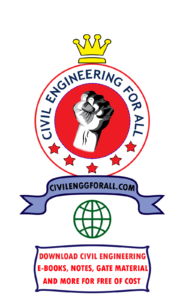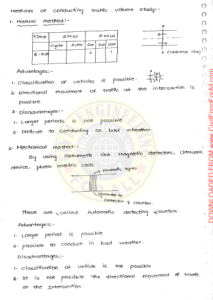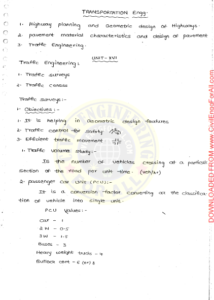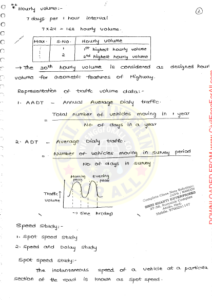
Table of Contents
TRANSPORTATION ENGINEERING
ASSISTANT ENGINEER & ASSISTANT EXECUTIVE ENGINEER
HANDWRITTEN NOTES
ACE ACADEMY TRAINING NOTES
FREE DOWNLOAD PDF
Transportation Engineering AE AEE Ace Academy Handwritten Notes PDF Free Download for Assistant Engineer government posts.


Assistant Executive Engineer (AEE) and Assistant Engineer (AE) are the government posts where Civil Engineers will be recruited in different departments like Irrigation, Rural, Roads, CAD, Ground Water, Tribal Welfare and more. There is a heavy competition for getting the AE and AEE government jobs in different states. ACE Academy is giving one of the top most quality in AE and AEE Government Exams coaching.
Download Transportation Engineering AE and AEE ACE Academy Handwritten Notes at CivilEnggForAll.

HIGHWAY ENGINEERING : During this period of Roman civilization many roads were built of stone blocks of considerable thickness. a features of the Roman roads They were built straight regardless of gradients. They were built after the soft soil was removed and a hard stratum was reached. The total thickness of the construction was as high as 0.75 to 1.2 metres at some places, even though the magnitude of wheel loads of animal drawn vehicles was very low. The wearing course consisted of dressed large stone-blocks set in lime mortar. Tresa et Construction Pierre Tresaguet(ITI6-1796) developed improved method of construction in France by the year 1764, A.D The main feature of his proposal was the thickness of construction need to be in the order of 30 cm Due consideration was given by him subgrade moisture condition and drainage of surface water. This suggested a dedicated research organization to research and development.

They resulted in the formation of Central Road Research(CRR) in 19t Institute DIAN ROADS, CONGRESS e Indian Roads Congress(IRC) was established in 1984 with the following object to promote and encourage the science and practice of road building and maintenance to provide a forum for expression of collective opinion of its members on matters of roads. To promote the use of standard specifications and practices. Lo advice regarding education, ex and research.To hold periodic meetings to discuss technical questions regarding roads. To suggest legislation for the development, improvement and protection of roads. To suggest improved methods of administration, planning, design, operation, us maintenance of roads. To establish, furnish and maintain libraries and museums for furthering the science making.
Nagpur Plan : In the Nagpur plan, roads were divided into four classes: National Highways, which would traverse several provinces or states and would be of G national importance for strategic, administrative and other purposes(ii Provincial and State Highways which would be the other main roads of a province or state(iii District Roads, which would take traffic from the main roads to the interior of each district or similar units. According to their importance, some of these are to be considered Major District Roads and the remaining as other District Roads. (Ivo village Roads, which would link the villages to the road system and would be designed, constructed and maintained under the authority of the provincial or state highway departments National Highway would be the framework within which the road system of the country should be developed and the financial responsibility of the Centre will have an effective say in the use and control of these roads. National and Provincial Highways and Major District Roads would be provided with a hard durable crust. The committee planned to construct 2 lakh kms of road across the country within 20 cities.

DOWNLOAD LINK : Transportation Engineering AE AEE Ace Academy Handwritten Notes PDF : CLICK HERE TO DOWNLOAD
SURVEYING AE AEE ACE ACADEMY HANDWRITTEN NOTES : CLICK HERE TO DOWNLOAD
STRUCTURAL ANALYSIS AE AEE ACE ACADEMY HANDWRITTEN NOTES : CLICK HERE TO DOWNLOAD
SURVEYING AE & AEE HANDWRITTEN NOTES : CLICK HERE
GENERAL SCIENCE AE AEE HANDWRITTEN NOTES : CLICK HERE
STRUCTURAL ANALYSIS AE & AEE HANDWRITTEN NOTES : CLICK HERE
PERT AND CPM AE AEE HANDWRITTEN NOTES PDF : CLICK HERE
Geography AE AEE Ace Academy Handwritten Notes PDF : CLICK HERE TO DOWNLOAD
Indian Polity AE AEE Civil Engineering Handwritten Notes PDF : CLICK HERE TO DOWNLOAD
Economics AE AEE Civil Engineering Handwritten Notes PDF : CLICK HERE TO DOWNLOAD
TSPSC AEE/AE SYLLABUS
Paper-I: GENERAL STUDIES AND GENERAL ABILITIES
1. Current affairs – Regional, National and International.
2. International Affairs.
3. General Science; India’s Achievements in Science and Technology.
4. Environmental issues; Disaster Management- Prevention and Mitigation Strategies.
5. Economic and Social Development of India and Telangana.
6. Physical, Social and Economic Geography of India.
7. Physical, Social and Economic Geography and Demography of Telangana.
8. Socio-economic, Political and Cultural History of Modern India with special emphasis on
Indian National Movement.
9. Socio-economic, Political and Cultural History of Telangana with special emphasis on
Telangana Statehood Movement and formation of Telangana state.
10. Indian Constitution; Indian Political System; Governance and Public Policy.
11. Social Exclusion; Rights issues such as Gender, Caste, Tribe, Disability etc. and
inclusive policies.
12. Society, Culture, Heritage, Literature of Telangana.
13. Policies of Telangana State.
14. Logical Reasoning; Analytical Ability and Data Interpretation.
15. Basic English. (10th class Standard)
PAPER-II: CIVIL ENGINEERING (DEGREE LEVEL)
1. Building Materials And Construction: Bricks– Types of Bricks, Indian standard classification, properties; Stones – Types of stones, classification, properties, dressing and polishing of stones; Methods of Quarrying; Cement – Different grades and types of cement, properties and IS specifications; Aggregates – coarse and fine aggregate, properties and IS specifications; Cement Mortar – Proportions of cement mortar for various applications; Concrete – Constituents of Concrete, Different grades of Concrete, mix proportioning using IS Code, Properties of fresh and hardened Concrete; Admixtures – Types of Admixtures
2. Strength of Materials And Theory of Structures: Strength of Materials: Simple stresses and strains, elastic constants and relationship between them; Compound bars; Temperature stresses; Shear forces and bending moment diagrams for beams; Principal stresses and Mohr’s circle of stress, Theory of bending and bending stresses ; Shear stress distribution; Theory of torsion; Springs; Deflections of beams; Thin and thick cylinders;; Analysis of trusses, Betti-Maxwell theorem; Shear centre and unsymmetrical bending. Theory of Structures: Direct and bending stresses; Columns and struts; Strain energy method; Moving loads and influence lines; Arches and suspension bridges; Static and kinematic indeterminacy; Moment distribution, Slope deflection, and Kani’s methods applied to continuous beams and portal frames; Column analogy and matrix methods of analysis.
3. RCC and Steel Structures: Concrete Structures: Materials, permissible stresses and IS Specifications; Working stress methods; Limit State Method – Stress Blocks parameters, design of Beams, Slabs, Columns and Footing; Design for Shear and Torsion; Design of Retaining Walls, Water tanks, and T-Beam Slab bridges; Yield line theory. Steel Structures: Properties of steel sections, permissible stresses, IS Specifications; Riveted and welded joints and connections; Design of simple and compound Beams and Columns, Column bases, Roof trusses, Plate and Gantry Girders; Plate Girder Lattice Girder Railway bridges, and Bearings. Plastic analysis.
Pre-Stressed Concrete: Basic concepts, material for pre-stressing, losses in Pre-stress, classification of pre-stressing system; Analysis of PSC Sections.
4. Fluid Mechanics and Hydraulics: Fluid Properties; Measurement of Pressure – Manometers; Fluid Kinematics – Classification of Fluids, Stream function and Velocity potential, significance and use of Flownets, Fluid dynamics – Continuity equation, Bernoulli’s equations and Impulse momentum equation; Laminar and Turbulent flow through pipes – significance of Reynolds number, Hagen – Poiseuille’s equation, Darcy – Weisbach equation, Friction factor, Water hammer phenomenon; Compressible flow – Bernoulli’s equation for Isothermal and Adiabatic conditions, Mach Number, Mach cone, stagnation properties; Steady uniform flow through open channels; Gradually varied flows – significance of Froude number, classification and computation of Flow profiles, Hydraulic jump, Surges; Boundary layer – Laminar and Turbulent Boundary layer, Boundary layer thickness, rough and smooth Boundaries, Boundary layer separation; Dimensional analysis and similarity laws; Hydraulic Turbines – classification, Velocity triangles, principles and design of reaction and impulse turbines; Centrifugal pumps – specific speed, work done and efficiency, characteristic curves.
5. Hydrology and Water Resources Engineering: Hydrological cycle; Rainfall – types and measurement, network design; Infiltration – Ф- index; Runoff – process, factors and determination of runoff, dependable yield; Floods –flood hydrograph, computation of flood peak using rational formula, unit hydrograph method and Gumbel’s extreme value methods; Groundwater – types of aquifer and properties, Darcy’s law, specific yield, steady radial flow to wells in confined and unconfined aquifers; Irrigation – types and advantages, soil water plant relationship, consumptive use, duty, delta, base period, crops and their water requirements; Single and multipurpose projects; Dams – classification, forces and design of Gravity dam and Earth dam; Spillways – types, energy dissipation, stilling basin, Appurtenances; Canals – alignment, Kennedy’s and Lacey’s theories, lining of Canals; Weirs – components, design of vertical drop and sloping glacis weir; Seepage forces – Bligh’s Theory, Khosla’s theory; Canal falls – types and design principles; Cross drainage works – classification and design principles of aqueducts; Hydropower – classification and principle components of Hydroelectric power plants.
6. Environmental Engineering: Water supply – objectives, rate of demand, population forecasts; Analysis of water – classification, design of coagulation, sedimentation, filtration, disinfection and softening processes; Methods of layout of distribution pipes – Hardy cross method; Waste water engineering – systems of sewerage, hydraulic formulae and design of sewers, BOD, COD, self purification of natural streams, methods of sewage disposal; Treatment of sewage – principles and design of grit chamber, sedimentation tanks, trickling filters, activated sludge process, sludge digestion tanks, septic tanks; Municipal solid waste – characteristics, collection and transportation of solid wastes; Air Pollution – types and sources of pollutants, air quality standards; Noise pollution – Impacts and permissible limits, measurement and control of noise pollution.
7. Transportation Engineering: Highway Classification as per IRC; Highway alignment; Engineering Surveys; Geometric Design; Cross sectional elements of road; Gradient; Grade compensation; Traffic Surveys – speed, Volumes, origin and destination; Highway capacity and level of service as per HCM 2000; Intersection – at grade and grade separated; Channelization; Rotary intersection; signal design – webstar method, traffic signs, pavement marking; Parking studies, accidental studies, pavement types, Factors considered for pavement design, flexible and rigid pavements design concepts. Railway Engineering: Permanent way, rails, sleepers, ballast; Creep, coning of wheel, rail fixtures and fastenings, super elevation, cant deficiency, curves, turnout; Points and crossings. Airport Engineering: Selection of site of Airport, runway orientation and design, wind rose diagram, basic run way length, correction to basic runway length.
8. Soil Mechanics and Foundation Engineering: Soil Mechanics: Physical properties of soils, Classification and identification, Permeability, Capillarity, Seepage, Compaction, Consolidation, Shear Strength, Earth pressure, Slope stability; Foundation Engineering: Site investigations, stress distribution in soils, Bearing capacity, Settlement analysis, Types of Foundation, Pile foundations, Foundations on expansive soils; swelling and its preventions; Coffer dams, Caissons, Dewatering, Bracing for excavations, Newmark charts, machine foundations.
Engineering Geology: Mineralogy, Structural Geology, Groundwater Exploration methods; Engineering Geology applications for Tunnels, Dams and Reservoirs; Geological hazards and preventive measures.
9. Estimation, Costing and Construction Management: Abstract estimate: Detailed estimate – centerline, long & short wall method, various items of Civil Engineering works as per Indian Standard, General Specifications – Earth Work, Brick / Stone Masonry in Cement Mortar, RCC, Plastering in Cement Mortar, Floor finishes, white wash, colour wash; Standard schedule of rates, lead and lift, preparation of lead statement; Computation of earth work – Mid-ordinate, Mean Sectional area, Trepezoidal method, Prismoidal Rule; Approximate estimate – Plinth area and cubic rate estimate.
10. Surveying: Principle and classification of surveying, chain surveying; Compass surveying; Levelling and contouring; Theodolite surveying; curves; Introduction and Fundamental concepts of electronic measuring instruments – EDM, Total station, GIS & GPS.
OTHER SEARCH RESULTS ::
transportation engineering ae aee material
transportation engineering ae aee material
transportation engineering ae aee tspsc material
ae aee civil engineering material
tspsc.gov.in ae aee posts
tspsc civil engineering material pdf free download
telangana state public service commission civil engineering posts
telangana state public service commission civil engineering books
telangana state public service commission civil engineering ae aee books pdf
ae aee transportation engineering
ae aee transportation engineering notes
ae aee transportation engineering notes free download
ae aee ace academy materials free download pds
ace academy ae aee civil engineering materials free download,
aee full form,
aee tspsc,
tspsc aee exam hall ticket download,
tspsc aee exam postponed,
www.hescom.co.in 2017,
www.hescom.com recruitment 2017,
www.hescom.co.in notification,
tspsc aee admit card 2017,
assistant executive engineer tspsc hall tickets 2017,
tspsc aee syllabus 2017,
aee tspsc hall ticket,
tspsc aee exam date 2017,
tspsc aee admit card 2017,
tspsc aee notification 2017 syllabus,
tspsc aee exam postponed,
tspsc aee syllabus for civil engineering,
tspsc aee hall ticket 2017,
tspsc hall ticket download 2017,
www.tspsc.gov.in 2017,
tspsc notifications 2017,
tspsc results,
www.tspsc.gov.in 2017 notification,
tspsc aee notification 2017,
tspsc hall ticket 2017,
tspsc aee syllabus for civil engineering,
aee syllabus 2017 pdf,
tspsc aee electrical syllabus,
tspsc aee syllabus 2017,
tspsc aee notification 2017 pdf,
tspsc aee exam postponed,
tspsc aee exam date,
aee exam previous papers,
appsc aee syllabus 2017 pdf,
aee syllabus for eee,
tspsc aee syllabus for electrical,
aee exam previous papers,
tspsc aee syllabus for civil engineering,
aee syllabus pdf,
tspsc aee civil syllabus pdf,
aee syllabus for civil engineering 2016 pdf,
tspsc aee syllabus electrical,
aee syllabus for eee,
aee exam previous papers,
tspsc aee syllabus for civil engineering pdf,
tspsc aee syllabus for electrical pdf,
tspsc aee syllabus for eee,
tspsc aee syllabus for mechanical engineering,
tspsc aee syllabus 2017 pdf,
tspsc one time registration login,
www.tspsc.gov.in 2017 notification,
www.tspsc.gov.in results,
tspsc.gov.in aee,
tspsc aee notification 2017,
tspsc tgt apply online,
tspsc hall ticket download 2017,
tspsc results,
tspsc aee hall ticket 2017,
tspsc hall ticket download 2017,
www.tspsc.gov.in 2017,
tspsc login,
www.tspsc.gov.in 2017 notification,
tspsc notifications 2017,
tspsc results,
tspsc hall ticket 2017 download

Leave a Reply